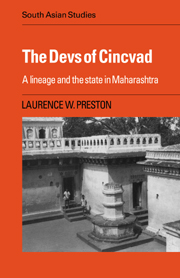Book contents
- Frontmatter
- Contents
- List of figures and tables
- Preface
- List of abbreviations and note on Indian technical usages
- Introduction: an inamdar lineage in Indian history
- PART ONE THE INAMDAR UNDER THE MARATHAS
- 1 The acquisition of inam
- 2 The preservation of inam, 1720–1818
- PART TWO THE INAMDAR UNDER THE BRITISH
- Bibliography
- Index
- CAMBRIDGE SOUTH ASIAN STUDIES
2 - The preservation of inam, 1720–1818
from PART ONE - THE INAMDAR UNDER THE MARATHAS
Published online by Cambridge University Press: 05 November 2011
- Frontmatter
- Contents
- List of figures and tables
- Preface
- List of abbreviations and note on Indian technical usages
- Introduction: an inamdar lineage in Indian history
- PART ONE THE INAMDAR UNDER THE MARATHAS
- 1 The acquisition of inam
- 2 The preservation of inam, 1720–1818
- PART TWO THE INAMDAR UNDER THE BRITISH
- Bibliography
- Index
- CAMBRIDGE SOUTH ASIAN STUDIES
Summary
After 1719/20 and the death of the third Dev Narayan, a gradual transformation overtook the Devs' relations with the inam granting powers. Seemingly less intent on expanding their holdings, to judge from available sources, the lineage now sought to establish itself in the ritual, social and economic hierarchies of the Peshvas' Maharashtra. Although the Devs' position in the fabric of eighteenth-century society was secure – a more solidly placed lineage is difficult to find – still, revenue received from the state and held at its pleasure had to be jealously guarded. Acquisitions were still important, and this chapter shows why an expanding inamdar lineage always needed more inam. Specific grants received after King Shahu's death in 1750 are therefore noted in passing in this and subsequent chapters. However, throughout the ascendancy of the Peshvas (and thereafter under the British) inam became an inheritance to be preserved from all possible encroachments. This prime duty of the inamdar both ordered the internal affairs of the lineage and animated its external relations with state and society. These twin and related aspects of the Devs' history are now examined in detail.
Because of the vicissitudes of the Maratha polity, even apparently secure alienated tenures were not immune from the ruler's financial demands. Periodic surveys of alienated tenures were ordered to determine which were improperly held. Political tenures, jagir and saranjam, were notoriously insecure, especially when government revenues were short.
- Type
- Chapter
- Information
- The Devs of CincvadA Lineage and the State in Maharashtra, pp. 46 - 84Publisher: Cambridge University PressPrint publication year: 1989



